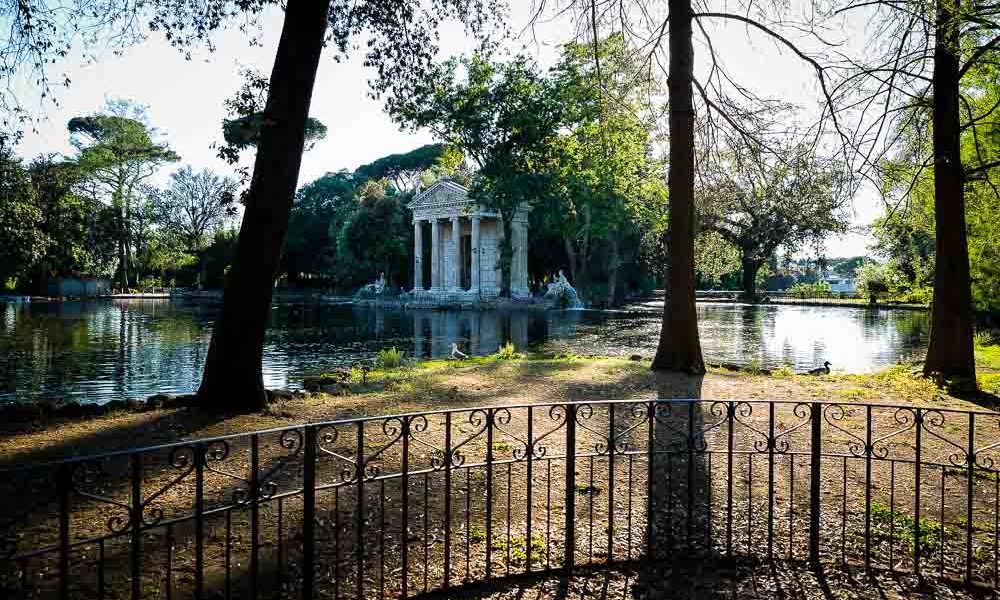The Best Lakes To Visit Near Rome
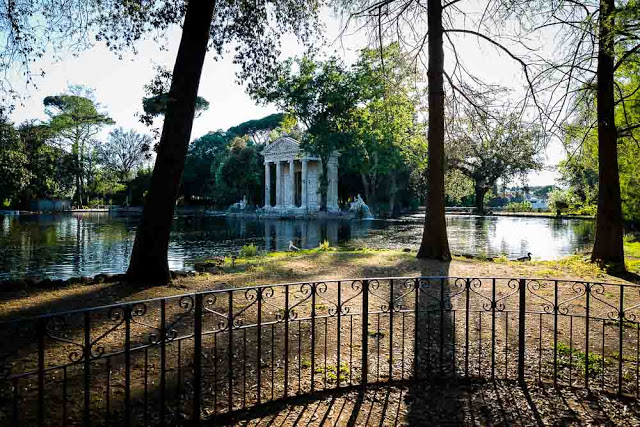
Rome has an almost overwhelming amount of ancient sites, bubbling fountains, spectacular art galleries, elaborate churches, bustling restaurants, and sprawling ‘piazze’ to experience. Whether visiting The Eternal City for the first or the twenty-first time, it is understandable that visitors often crave a break from Rome, especially if visiting during the summer heat. Read Beating the Heat in Rome for some other ideas about how to survive sightseeing in Rome during the summer months, especially June, July, and August.
The gorgeous volcanic lakes in Rome’s region of Lazio are a perfect way to escape the hustle and bustle of Rome and a jam-packed tourist itinerary. Head to one of the six lakes below for the day or the weekend. The best time of year for a lake trip is between May and October. The lakes near Rome are well kept secrets; most tourists miss out on visiting them. When visiting Rome, think beyond the historical metropolis and look to the divine countryside for the true Roman experience.
The Popes’ Summer Haven: Lago diAlbano
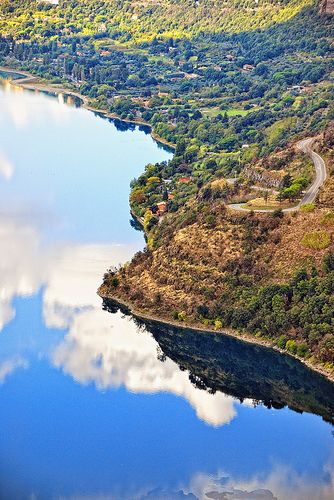
Only a forty minute train ride from Roma Termini Station, Lake Albano is the perfect natural escape from Italy’s capital city. Lago di Albano sits in a deep volcanic crater and the bright blue water seems to dip below the surrounding greenery. Visitors come here year-round, but especially in the summer months when people can sunbath, swim, rent boats, and picnic on the shore.
There is a large, public beach on the west side of the lake, but visitors can also find small, secluded spots away from this more popular area. Rent paddle boats, kayaks, or stand up paddle boards. Remember to bring an official form of ID for renting. Typically, boats do not cost more than €10 per hour. Either bring a picnic lunch or enjoy a leisurely lunch at one of the several, authentic restaurants in the town of Castel Gandolfo, near the lake’s main beach.

Peek inside the grand inner world of the Pope by visiting the Papel Palace in Castel Gandolfo. The Pope’s impressive summer home is also called the Apostolic Palace of Castel Gandolfo or the ‘Palazzo Apostolico di Castel Gandolfo’ in Italian. Historically, it has been the summer escape for each Pope. However, unlike many of his predecessors, Pope Francis rarely uses it and has opened the Papel Palace to the public as a museumrun by the Vatican Museums. Explore the twenty highly decorated rooms, which have never previously been seen by the public. Entrance to the palace and gardens costs €11.00.
To get to Castel Gandolfo from Rome, buy train tickets at Roma Termini Station or online at Trenitalia. To be safe, buy roundtrip train tickets before leaving as there is only one tiny ticket machine at the small Castel Gandolfo stop. Roundtrip tickets cost €4.20 each. Alternatively, book a private car from Rome.
The Lake with the Sunken Roman Ships: Lago di Nemi
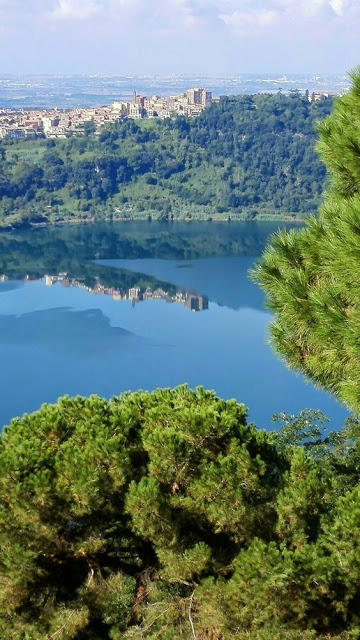
Close to Lake Albano, about one-hour southeast of Rome by car, is a smaller crater lake, called Lake Nemi. This lake is most famous for its shipwrecks; in 1446 divers confirmed rumors that two Roman ships sat eighteen meters below the surface of the lake. These ornate ships were built in the first century AD by Emperor Caligula. The divers were unable to recover them and subsequent attempts throughout the centuries were also unsuccessful. The ships were finally pulled up in 1927, when Benito Mussolini demanded that Lake Nemi be partially drained. Learn more about the history of the ships at the ‘Museo delle Navi Romane.’
The town of Nemi is perched above the lake in the green Alban Hills. Admire the tenth century Castello Ruspoli in the town. Nemi hosts an annual ‘Sagra della Fragola’ or Strawberry Festival, so be sure to try the wild strawberry, called ‘fragoline di bosco’ in Italian, when visiting from May to June. Read more about the Italian ‘Sagra’ Experience.
A Crystal Clear Swimming Spot and Water Supply: Lago di Bracciano
Another haven for Rome’s city dwellers and summer vacationers, which was also created by a volcano, is Lazio’s most celebrated lake, Lago di Bracciano. The lake and the nearby Lago di Martignano were created between 40,000 and 60,000 years ago by forceful volcanic activity. The two lakes are protected as part of the Bracciano-Martignano Natural Park. Lake Bracciano is a water reservoir for Rome. To uphold the quality of the water, motorboats are not allowed on the lake, which means that not only is the lake quiet and relaxing, the water is dazzlingly clean. People swim, sail, windsurf, and rent paddle boats and canoes. The beautiful countryside in ‘Parco Naturale di Bracciano-Martignano’ also provides excellent cycling and hiking opportunities.
The picturesque town of Bracciano is in the hills above the lake. Visit Bracciano’s impressive fifteenth century castle, Castello Orsini-Odescalchi, which overlooks the water below. The castle is a popular wedding venue for exclusive celebrity weddings; Katie Holmes and Tom Cruise were married at the castel. Go inside the Castel Odescalchi di Bracciano Museumto see the collection of medieval armor, weaponry, artwork, and furniture. Full price tickets are €8.50 each. Walk through the enchanting streets of Bracciano and take in the gorgeous view from ‘Belvedere della Sentinella.’ There are plenty of delightful restaurants to eat lunch or dinner. Two other quaint, nearby towns are Trevignano and Anguillara.
Roundtrip train tickets from Roma Trastevere station, in the charming, restaurant and cafe filled Trastevere neighborhood, to Bracciano are €6.00 on Trenitalia. The train ride takes about an hour and five minutes. Driving from Rome takes thirty to forty-five minutes, depending on traffic. Read Italy’s Three Best Road Tripsfor some tips about renting a car and driving in Italy.
A Perfectly Formed Crater Lake: Lago di Martignano
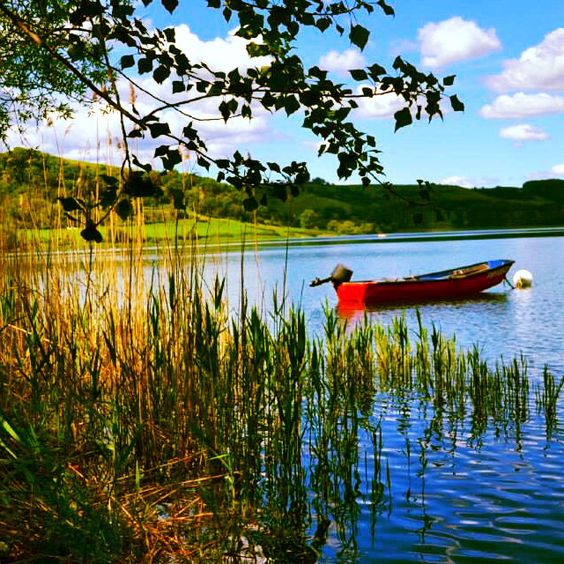
Not far from Lake Bracciano, is the much smaller, but just as incredible, Lake Martignano. This volcanic crater lake and the surrounding, protected wilderness offers superb swimming, canoeing, kayaking, horse riding, trekking, and cycling. The bright blue water is refreshing and sparklingly clear. Like the other lakes, there are beaches with boats, umbrellas, chairs, and sun beds available to rent. Bring a picnic lunch or eat at one of the Italian restaurants along the water. There are several ‘agriturismi,’ or working farms, nearby, which have tasty restaurants that use ingredients grown on their own farms. The ‘agriturismo’ restaurants are affordable and bursting with flavorful, traditional food.
Roughly an hour away, it is easiest to reach Lake Martignano from Rome by driving. Either rent a car or hire a private car to get to the lake. After parking, there is a slightly tough, ten minute hike down to the lake, which may not be suitable for young children or elderly travelers.
Europe’s Largest Volcanic Lake: Lago di Bolsena
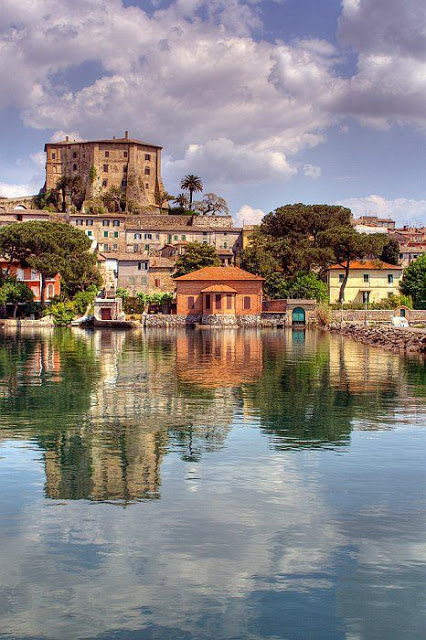
With a twenty-seven mile (forty-three kilometer) circumference, Lake Bolsena is the largest lake in Italy’s region of Lazio. Lago di Bracciano is the second largest lake in Lazio. Spanning an area of forty-four square miles (115 square kilometers), Lake Bolsena is also the largest volcanic lake in all of Europe. It formed about 370,000 years ago, when volcanic eruptions created an indent in the earth, which was then naturally filled with water. Even underwater, two volcanoes kept erupting and eventually became the lake’s islands, L’Isola Bisentina and L’Isola Martana. Martana Island is private property, while Bisentina Island is open the public. It is full of history, showcasing churches, temples, and gardens.
Bordering Tuscany, Lake Bolsena was an important Etruscan area around 650 BC, when the Etruscans were Italy’s most powerful group. Read Travel, Food, and Wine on a Budget in Tuscanyif visiting the lake’s breathtaking, neighboring region.
The lake is nicknamed, ‘Il Lago che Si Beve,’ which translates to “The Lake You Can Drink,” because the water is so stunningly clear and fish are abundant. Many of the beaches are pebbled or have shining, black volcanic sand. The brillantly blue water offers pristine swimming, boating, windsurfing, fishing, and scuba diving. Rent a motorboat, sailboat, or kayak at one of the lake’s two ports; Bolsena and Capodimonte. Winds can pick up on the large lake, so be sure to always wear life jackets if going out on a boat. Boat tours of the whole lake, including Bisentina Island, are available.
Lake Bolsena is a two hour drive from Rome. It also lies on the ‘Via Francigena,’ the ancient pilgrimage that began in Canterbury and ended in Rome, so people embarking on the pilgrimage today can stop by the lake as they hike.
A Lake Created by the Gods: Lago di Vico
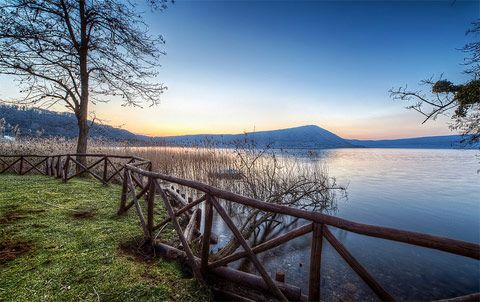
According to ancient legend, Lago di Vico sprang up when Hercules launched his club and created a massive hole in the earth when it hit the ground. Legend says that the hole was quickly filled by a nearby stream. However, despite the wonderful myth, it is more likely that the lake was created by volcanic activity over 100,000 years ago and then was filled with rain fall and water from underground springs. Read Italy’s Top Natural Hot Springsto find out where to find the best natural ‘terme.’
Similar to Lake di Bracciano and Lago di Martignano, Lake Vico is protected. It is part of the Lake Vico Nature Reserve in the luscious Cimini Hills. Motor boats are also banned here and wildlife flourishes. The water is also used as a drinking water reservoir for Rome. The crystal-like water is ideal for swimming, canoeing, and kayaking.
Explore the lake’s nearest town, Ronciglione, which is filled with Baroque style churches, medieval castle, and winding, whimsical streets. Lake Vico is about one hour north from Rome and is most easily reached by car.
From all of us at Roman Candle Tours, enjoy exploring the lakes of Lazio. Spring back to life after a refreshing dip in one of the lakes or by watching a spectacular sunset over the glistening water.
If you liked this article, read also “FAMOUS MOVIES IN ROME: SEEKING OUT THE SETS AND RECREATING THE MOMENTS“
